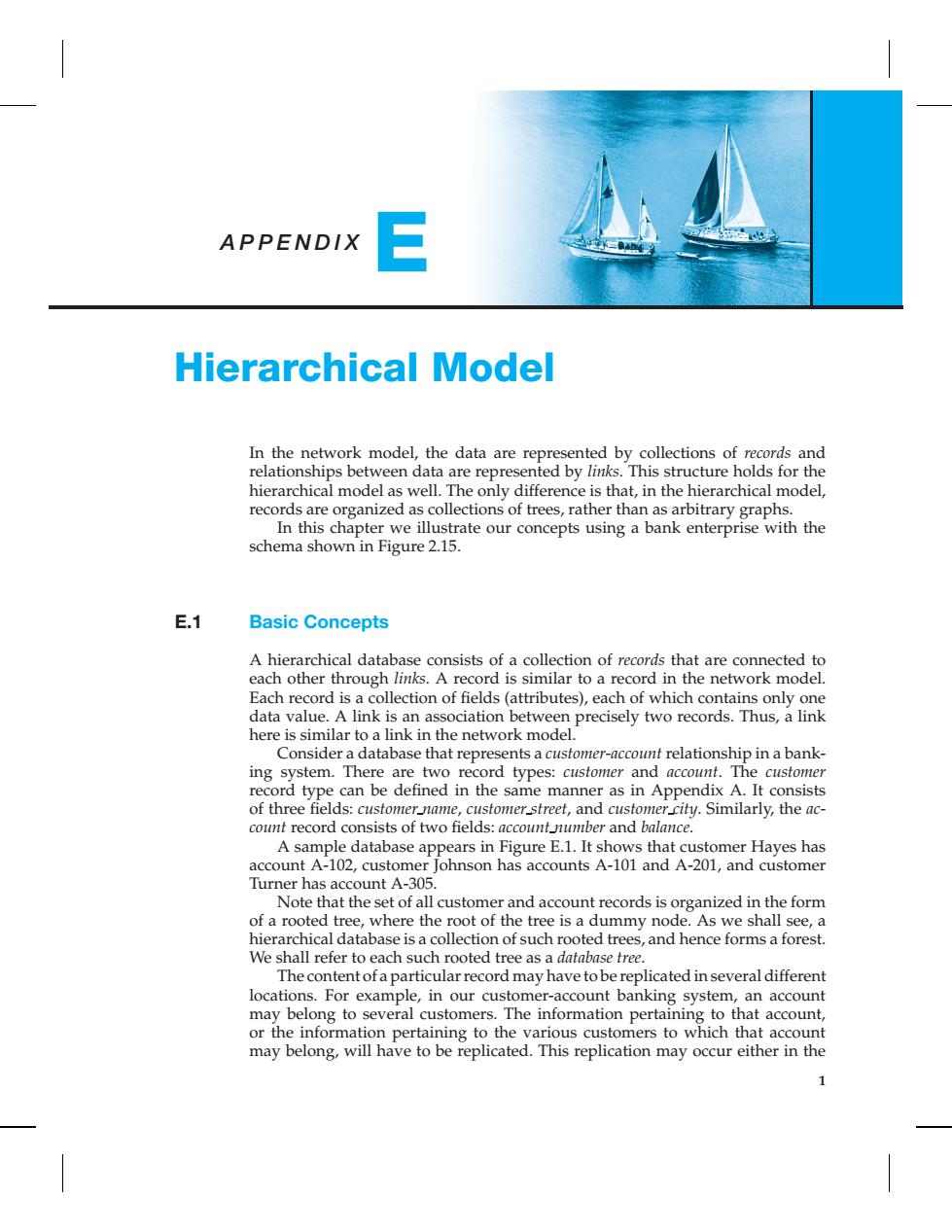正在加载图片...

APPENDIX Hierarchical Model In the network model,the data are represented by collections of records and relationships between data are represented by links.This structure holds for the hierarchical model as well.The only difference is that,in the hierarchical model, records are organized as collections of trees,rather than as arbitrary graphs. In this chapter we illustrate our concepts using a bank enterprise with the schema shown in Figure 2.15. E.1 Basic Concepts A hierarchical database consists of a collection of records that are connected to each other through links.A record is similar to a record in the network model. Each record is a collection of fields(attributes),each of which contains only one data value.A link is an association between precisely two records.Thus,a link here is similar to a link in the network model. Consider a database that represents a customer-account relationship in a bank- ing system.There are two record types:customer and account.The customer record type can be defined in the same manner as in Appendix A.It consists of three fields:customer name,customer street,and customercity.Similarly,the ac- count record consists of two fields:account number and balance. A sample database appears in Figure E.1.It shows that customer Hayes has account A-102,customer Johnson has accounts A-101 and A-201,and customer Turner has account A-305. Note that the set of all customer and account records is organized in the form of a rooted tree,where the root of the tree is a dummy node.As we shall see,a hierarchical database is a collection of such rooted trees,and hence forms a forest. We shall refer to each such rooted tree as a database tree. The content of a particular record may have to be replicated in several different locations.For example,in our customer-account banking system,an account may belong to several customers.The information pertaining to that account, or the information pertaining to the various customers to which that account may belong,will have to be replicated.This replication may occur either in the 1APPENDIXE Hierarchical Model In the network model, the data are represented by collections of records and relationships between data are represented by links. This structure holds for the hierarchical model as well. The only difference is that, in the hierarchical model, records are organized as collections of trees, rather than as arbitrary graphs. In this chapter we illustrate our concepts using a bank enterprise with the schema shown in Figure 2.15. E.1 Basic Concepts A hierarchical database consists of a collection of records that are connected to each other through links. A record is similar to a record in the network model. Each record is a collection of fields (attributes), each of which contains only one data value. A link is an association between precisely two records. Thus, a link here is similar to a link in the network model. Consider a database that represents a customer-account relationship in a banking system. There are two record types: customer and account. The customer record type can be defined in the same manner as in Appendix A. It consists of three fields: customer name, customer street, and customer city. Similarly, the account record consists of two fields: account number and balance. A sample database appears in Figure E.1. It shows that customer Hayes has account A-102, customer Johnson has accounts A-101 and A-201, and customer Turner has account A-305. Note that the set of all customer and account records is organized in the form of a rooted tree, where the root of the tree is a dummy node. As we shall see, a hierarchical database is a collection of such rooted trees, and hence forms a forest. We shall refer to each such rooted tree as a database tree. The content of a particular record may have to be replicated in several different locations. For example, in our customer-account banking system, an account may belong to several customers. The information pertaining to that account, or the information pertaining to the various customers to which that account may belong, will have to be replicated. This replication may occur either in the 1